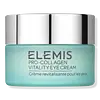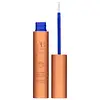What's inside
What's inside
 Key Ingredients
Key Ingredients

 Benefits
Benefits

 Concerns
Concerns

 Ingredients Side-by-side
Ingredients Side-by-side

Water
Skin ConditioningLaminaria Digitata Extract
Skin ProtectingCoco-Caprylate
EmollientChondrus Crispus Extract
Skin ConditioningGigartina Stellata Extract
Skin ProtectingPropanediol
SolventIsononyl Isononanoate
EmollientGlycerin
HumectantButyrospermum Parkii Butter
Skin ConditioningOryza Sativa Starch
AbsorbentCarbomer
Emulsion StabilisingPhenoxyethanol
PreservativeCamellia Oleifera Seed Oil
Skin ConditioningHydroxyacetophenone
AntioxidantPanthenol
Skin ConditioningSodium Polyacrylate
AbsorbentSodium Hydroxide
BufferingSodium Benzoate
MaskingDisodium EDTA
Padina Pavonica Thallus Extract
Skin ConditioningSambucus Nigra Flower Extract
RefreshingPotassium Sorbate
PreservativeRhizobian Gum
Sodium Hyaluronate
HumectantCrataegus Monogyna Flower Extract
Skin ConditioningParfum
MaskingJasminum Sambac Flower Extract
MaskingLactic Acid
BufferingChlorphenesin
AntimicrobialArtemisia Capillaris Flower Extract
Skin ConditioningChlorella Vulgaris Extract
Skin ConditioningCollagen Amino Acids
MoisturisingCitric Acid
BufferingTocopherol
AntioxidantLeuconostoc/Radish Root Ferment Filtrate
AntimicrobialWater, Laminaria Digitata Extract, Coco-Caprylate, Chondrus Crispus Extract, Gigartina Stellata Extract, Propanediol, Isononyl Isononanoate, Glycerin, Butyrospermum Parkii Butter, Oryza Sativa Starch, Carbomer, Phenoxyethanol, Camellia Oleifera Seed Oil, Hydroxyacetophenone, Panthenol, Sodium Polyacrylate, Sodium Hydroxide, Sodium Benzoate, Disodium EDTA, Padina Pavonica Thallus Extract, Sambucus Nigra Flower Extract, Potassium Sorbate, Rhizobian Gum, Sodium Hyaluronate, Crataegus Monogyna Flower Extract, Parfum, Jasminum Sambac Flower Extract, Lactic Acid, Chlorphenesin, Artemisia Capillaris Flower Extract, Chlorella Vulgaris Extract, Collagen Amino Acids, Citric Acid, Tocopherol, Leuconostoc/Radish Root Ferment Filtrate
Water
Skin ConditioningPolyglyceryl-10 Stearate
Skin ConditioningPentylene Glycol
Skin ConditioningHelianthus Annuus Seed Oil
EmollientUndaria Pinnatifida Extract
Skin ConditioningPanthenol
Skin ConditioningPropanediol
SolventGlycerin
HumectantPolyglyceryl-3 Diisostearate
EmulsifyingCarthamus Tinctorius Flower Extract
Skin ConditioningHibiscus Sabdariffa Flower Extract
Skin ConditioningSodium Benzoate
MaskingCarbomer
Emulsion StabilisingRicinus Communis Seed Oil
MaskingCitric Acid
BufferingO-Cymen-5-Ol
AntimicrobialHydrolyzed Hyaluronic Acid
HumectantBiotin
AntiseborrhoeicHydrolyzed Rice Protein
Skin ConditioningMaltodextrin
AbsorbentChondrus Crispus Extract
Skin ConditioningSodium Hydroxide
BufferingLactic Acid
BufferingSodium Hyaluronate
HumectantAloe Barbadensis Leaf Juice Powder
Skin ConditioningCamellia Sinensis Leaf Extract
AntimicrobialHydrogenated Lecithin
EmulsifyingTocopheryl Acetate
AntioxidantXanthan Gum
EmulsifyingPotassium Sorbate
PreservativeTocopherol
AntioxidantAlanyl Glutamine
HumectantArginine
MaskingOligopeptide-177
Phenylalanine
MaskingSisymbrium Irio Seed Oil
MaskingSodium Chloride
MaskingWater, Polyglyceryl-10 Stearate, Pentylene Glycol, Helianthus Annuus Seed Oil, Undaria Pinnatifida Extract, Panthenol, Propanediol, Glycerin, Polyglyceryl-3 Diisostearate, Carthamus Tinctorius Flower Extract, Hibiscus Sabdariffa Flower Extract, Sodium Benzoate, Carbomer, Ricinus Communis Seed Oil, Citric Acid, O-Cymen-5-Ol, Hydrolyzed Hyaluronic Acid, Biotin, Hydrolyzed Rice Protein, Maltodextrin, Chondrus Crispus Extract, Sodium Hydroxide, Lactic Acid, Sodium Hyaluronate, Aloe Barbadensis Leaf Juice Powder, Camellia Sinensis Leaf Extract, Hydrogenated Lecithin, Tocopheryl Acetate, Xanthan Gum, Potassium Sorbate, Tocopherol, Alanyl Glutamine, Arginine, Oligopeptide-177, Phenylalanine, Sisymbrium Irio Seed Oil, Sodium Chloride
Ingredients Explained
These ingredients are found in both products.
Ingredients higher up in an ingredient list are typically present in a larger amount.
Carbomer is a polymer of acrylic acid. Its main role is to create a gel consistency.
A high amount of carbomer can cause pilling or balling up of products. Don't worry, most products contain 1% or less of carbomer.
Chondrus Crispus Extract comes from a red algae native to the northern Atlantic coasts of Europe and North America. It helps hydrate the skin and is rich in antioxidants.
The antioxidants in chondrus crispus include lutein and zeaxanthin. Lutein has the ability to filter blue light from screens.
Other contents of chondrus crispus include polysaccharides, peptides, and amino acids. These help hydrate the skin.
What's the difference between algae and seaweed?
Algae is a broad term that includes seaweed. Not all algae is seaweed.
Citric Acid is an alpha hydroxy acid (AHA) naturally found in citrus fruits like oranges, lemons, and limes.
Like other AHAs, citric acid can exfoliate skin by breaking down the bonds that hold dead skin cells together. This helps reveal smoother and brighter skin underneath.
However, this exfoliating effect only happens at high concentrations (20%) which can be hard to find in cosmetic products.
Due to this, citric acid is usually included in small amounts as a pH adjuster. This helps keep products slightly more acidic and compatible with skin's natural pH.
In skincare formulas, citric acid can:
While it can provide some skin benefits, research shows lactic acid and glycolic acid are generally more effective and less irritating exfoliants.
Most citric acid used in skincare today is made by fermenting sugars (usually from molasses). This synthetic version is identical to the natural citrus form but easier to stabilize and use in formulations.
Read more about some other popular AHA's here:
Learn more about Citric AcidGlycerin is already naturally found in your skin. It helps moisturize and protect your skin.
A study from 2016 found glycerin to be more effective as a humectant than AHAs and hyaluronic acid.
As a humectant, it helps the skin stay hydrated by pulling moisture to your skin. The low molecular weight of glycerin allows it to pull moisture into the deeper layers of your skin.
Hydrated skin improves your skin barrier; Your skin barrier helps protect against irritants and bacteria.
Glycerin has also been found to have antimicrobial and antiviral properties. Due to these properties, glycerin is often used in wound and burn treatments.
In cosmetics, glycerin is usually derived from plants such as soybean or palm. However, it can also be sourced from animals, such as tallow or animal fat.
This ingredient is organic, colorless, odorless, and non-toxic.
Glycerin is the name for this ingredient in American English. British English uses Glycerol/Glycerine.
Learn more about GlycerinLactic Acid is another well-loved alpha hydroxy acid (AHA). It is gentler than glycolic acid but still highly effective.
Its main role is to exfoliate the surface of the skin by loosening the “glue” that holds dead skin cells together. Shedding those old cells leads to smoother, softer, and more even-toned skin.
Because lactic acid molecules are larger than glycolic acid, they don’t penetrate as deeply. This means they’re less likely to sting or irritate, making it a great choice for beginners or those with sensitive skin.
Like glycolic acid, it can:
Lactic acid also acts as a humectant (like hyaluronic acid). It can draw water into the skin to improve hydration and also plays a role in the skin's natural moisturizing factor (NMF) in the form of sodium lactate.
Studies show it can boost ceramide production to strengthen the skin barrier and even help balance the skin’s microbiome.
To get results, choose products with a pH between 3-4.
Lower strengths (5-12%) focus on surface exfoliation; higher strengths (12% and up) can reach deeper in the dermis (deeper, supportive layer) to improve skin texture and firmness over time.
Though it was originally derived from milk, most modern lactic acid used in skincare is vegan. It is made through non-dairy fermentation to create a bio-identical and stable form suitable for all formulations.
When lactic acid shows up near the end of an ingredient list, it usually means the brand added just a tiny amount to adjust the product’s pH.
Legend has it that Cleopatra used to bathe in sour milk to help reduce wrinkles.
Lactic acid is truly a gentle multitasker: it exfoliates, hydrates, strengthens, and brightens. It's a great ingredient for giving your skin a smooth, glowing, and healthy look without the harshness of stronger acids.
Read more about some other popular AHA's here:
Learn more about Lactic AcidPanthenol is a common ingredient that helps hydrate and soothe the skin. It is found naturally in our skin and hair.
There are two forms of panthenol: D and L.
D-panthenol is also known as dexpanthenol. Most cosmetics use dexpanthenol or a mixture of D and L-panthenol.
Panthenol is famous due to its ability to go deeper into the skin's layers. Using this ingredient has numerous pros (and no cons):
Like hyaluronic acid, panthenol is a humectant. Humectants are able to bind and hold large amounts of water to keep skin hydrated.
This ingredient works well for wound healing. It works by increasing tissue in the wound and helps close open wounds.
Once oxidized, panthenol converts to pantothenic acid. Panthothenic acid is found in all living cells.
This ingredient is also referred to as pro-vitamin B5.
Learn more about PanthenolPotassium Sorbate is a preservative used to prevent yeast and mold in products. It is commonly found in both cosmetic and food products.
This ingredient comes from potassium salt derived from sorbic acid. Sorbic acid is a natural antibiotic and effective against fungus.
Both potassium sorbate and sorbic acid can be found in baked goods, cheeses, dried meats, dried fruit, ice cream, pickles, wine, yogurt, and more.
You'll often find this ingredient used with other preservatives.
Learn more about Potassium SorbatePropanediol is an all-star ingredient. It softens, hydrates, and smooths the skin.
It’s often used to:
Propanediol is not likely to cause sensitivity and considered safe to use. It is derived from corn or petroleum with a clear color and no scent.
Learn more about PropanediolSodium Benzoate is a preservative. It's used in both cosmetic and food products to inhibit the growth of mold and bacteria. It is typically produced synthetically.
Both the US FDA and EU Health Committee have approved the use of sodium benzoate. In the US, levels of 0.1% (of the total product) are allowed.
Sodium benzoate works as a preservative by inhibiting the growth of bacteria inside of cells. It prevents the cell from fermenting a type of sugar using an enzyme called phosphofructokinase.
It is the salt of benzoic acid. Foods containing sodium benzoate include soda, salad dressings, condiments, fruit juices, wines, and snack foods.
Studies for using ascorbic acid and sodium benzoate in cosmetics are lacking, especially in skincare routines with multiple steps.
We always recommend speaking with a professional, such as a dermatologist, if you have any concerns.
Learn more about Sodium BenzoateSodium Hyaluronate is hyaluronic acid's salt form. It is commonly derived from the sodium salt of hyaluronic acid.
Like hyaluronic acid, it is great at holding water and acts as a humectant. This makes it a great skin hydrating ingredient.
Sodium Hyaluronate is naturally occurring in our bodies and is mostly found in eye fluid and joints.
These are some other common types of Hyaluronic Acid:
Learn more about Sodium HyaluronateSodium Hydroxide is also known as lye or caustic soda. It is used to adjust the pH of products; many ingredients require a specific pH to be effective.
In small amounts, sodium hydroxide is considered safe to use. However, large amounts may cause chemical burns due to its high alkaline.
Your skin has a natural pH and acid mantle. This acid mantle helps prevent harmful bacteria from breaking through. The acid mantle also helps keep your skin hydrated.
"Alkaline" refers to a high pH level. A low pH level would be considered acidic.
Learn more about Sodium HydroxideTocopherol (also known as Vitamin E) is a common antioxidant used to help protect the skin from free-radicals and strengthen the skin barrier. It's also fat soluble - this means our skin is great at absorbing it.
Vitamin E also helps keep your natural skin lipids healthy. Your lipid skin barrier naturally consists of lipids, ceramides, and fatty acids. Vitamin E offers extra protection for your skin’s lipid barrier, keeping your skin healthy and nourished.
Another benefit is a bit of UV protection. Vitamin E helps reduce the damage caused by UVB rays. (It should not replace your sunscreen). Combining it with Vitamin C can decrease sunburned cells and hyperpigmentation after UV exposure.
You might have noticed Vitamin E + C often paired together. This is because it is great at stabilizing Vitamin C. Using the two together helps increase the effectiveness of both ingredients.
There are often claims that Vitamin E can reduce/prevent scarring, but these claims haven't been confirmed by scientific research.
Learn more about TocopherolWater. It's the most common cosmetic ingredient of all. You'll usually see it at the top of ingredient lists, meaning that it makes up the largest part of the product.
So why is it so popular? Water most often acts as a solvent - this means that it helps dissolve other ingredients into the formulation.
You'll also recognize water as that liquid we all need to stay alive. If you see this, drink a glass of water. Stay hydrated!
Learn more about Water